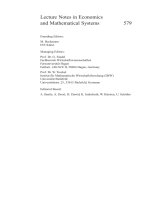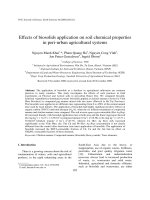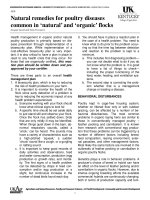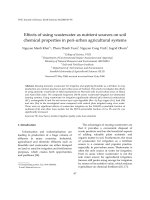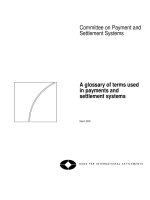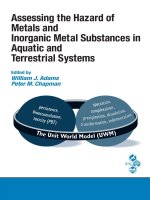Weed Ecology in Natural and Agricultural Systems
Bạn đang xem bản rút gọn của tài liệu. Xem và tải ngay bản đầy đủ của tài liệu tại đây (2.76 MB, 313 trang )
Weed Ecology in Natural and Agricultural Systems
Weed Ecology in Natural and
Agricultural Systems
Barbara D. Booth
Department of Plant Agriculture
University of Guelph
Canada
Stephen D. Murphy
Department of Environment and Resource Studies
University of Waterloo
Canada
and
Clarence J. Swanton
Department of Plant Agriculture
University of Guelph
Canada
CABI Publishing
CABI Publishing is a division of CAB International
CABI Publishing
CAB International
Wallingford
Oxon OX10 8DE
UK
Tel: +44 (0)1491 832111
Fax: +44 (0)1491 833508
E-mail:
Web site: www.cabi-publishing.org
CABI Publishing
44 Brattle Street
4th Floor
Cambridge, MA 02138
USA
Tel: +1 617 395 4056
Fax: +1 617 354 6875
E-mail:
©CAB International 2003. All rights reserved. No part of this publication may be reproduced in any
form or by any means, electronically, mechanically, by photocopying, recording or otherwise,
without the prior permission of the copyright owners.
A catalogue record for this book is available from the British Library, London, UK.
Library of Congress Cataloging-in-Publication Data
Booth, Barbara D.
Weed ecology in natural and agricultural systems/Barbara D. Booth, Stephen D. Murphy, and
Clarence J. Swanton.
p. cm.
Includes bibliographical references (p. ).
ISBN 0-85199-528-4 (alk. paper)
1. Weeds—Ecology. 2. Weeds. I. Murphy, Stephen D.
II. Swanton, Clarence J. III. Title.
SB611.B59 2003
632’.5—dc21
2002010884
ISBN 0 85199 528 4
Typeset by Wyvern 21 Ltd, Bristol
Printed and bound in the UK by Biddles Ltd, Guildford and King’s Lynn
Contents
Preface
1. Ecology of Weeds
vii
1
Part I. Population Ecology
2. Describing the Distribution and Abundance of Populations
3. The Structure and Dynamics of Populations
4. Sexual Reproduction
5. Asexual Reproduction
6. From Seed to Seedling
7. Growing Up, Getting Old and Dying
15
17
29
49
63
81
101
Part II. Interactions Between Populations
8. Interactions Between Populations I: Competition and Allelopathy
9. Interactions Between Populations II: Herbivory, Parasitism and Mutualisms
10. Studying Populations and Their Interactions
117
119
139
155
Part III. Community Ecology
11. Basic Community Concepts and Diversity
12. Community Dynamics: Succession and Assembly
13. Plant Invasions
14. Studying Community Structure and Dynamics
179
181
207
235
255
Part IV. Conclusions
15. The Importance of Weed Ecology to Management
275
277
Part V. Appendix
Glossary
285
287
Subject Index
293
Species Index
299
v
Preface
Our goal in writing this book was to describe
why weeds occur where they do. We have
made no attempt to discuss their management and control: there are excellent texts
available for that. Rather, we think that students should understand how and why
weeds fit into their environment. This text
presents ecological principles as they relate
to weeds. Ecology is central to our understanding of how and why weeds invade and
yet there are few books that make this connection. That is the niche we hope to fill.
We make no excuses for using the word
‘weed’, and, since humans decide what
species are considered to be a weed, we
make no attempt at a detailed definition. We
could really have used the word ‘plant’
throughout the text. We have tried to present
a broad array of weed examples, and have
therefore selected weed examples from different types of systems – agricultural, managed (e.g. forestry) and natural systems – and
from around the world.
The book was designed as a teaching
text for a middle year undergraduate course.
No ecological background is assumed,
although some basic biology is required. We
have tried to write it and arrange the material so that it is presented in a clear concise
manner. At the beginning of each chapter,
we have listed concepts that will be
addressed, as an overview of what is to
come, and to assist the reader when reviewing the material. At the end of each chapter
there is a list of questions, the first of which
refers to a weed of your (the student’s)
choice. It can be a common widespread
weed, or it may be a local problem. You will
be asked to summarize information that is
known about your weed in relation to the
material discussed in each chapter. There
may be a lot or very little information available to you. The idea behind this is to apply
the ecological principles you learn in the
chapter to a weed of interest, and to give you
practice in researching a topic. Our hope is
that by the end of the book, you will have
created a ‘case history’ of your chosen weed.
For the instructor, we designed this
book so that the material could be covered in
a single-term course by covering approximately one ‘content chapter’ per week.
Chapters 1 and 15 are a brief introduction
and conclusion. Two chapters (10 and 14)
discuss how ecology ‘is done’, i.e. methodology, experimental design and basic calculations. These can be used as you see fit. We
have tried to keep the writing precise and
concise and to include only pertinent information. If we have done our job well, students should be able to read and understand
all of the information.
vii
viii
Preface
We have used common names throughout the text with Latin names given the first
time the species is mentioned in each chapter. We did this because common names are
easier to remember when first learning about
a species. A species list of common and
Latin names is provided at the end of the
book.
We thank many people who assisted in
the writing and production of this book.
David Clements and Jason Cathcart provided
detailed comments on many versions of the
text. Cheryl Corbett, Sara Mohr and Sheryl
Lonsbary read sections or chapters. Of
course we accept the responsibility for any
errors that occur. We also thank the authors
and publishers who allowed us to use their
illustrations and Tim Hardwick of CAB
International who kept us on in spite of
many missed deadlines.
Finally, we thank our spouses, David
Beattie, Tara Murphy and Josee Lapierre,
who probably heard more about ‘the book’
than they wanted, but kept smiling and nodding their heads anyway. We dedicate this
book to them.
1
Ecology of Weeds
Concepts
• The terms ‘weed’, ‘invader’, ‘colonist’, ‘exotic’, ‘non-native’ and others are often used in
overlapping and conflicting manners.
• Weeds are classified based on their impact on human activities. Therefore, the effect of
a weed is difficult to quantify because it depends on our personal biases.
• Definitions and classifications in ecology are often arbitrary and made for purely practical reasons. They do not necessarily reflect any innate structure of nature.
• Ecology can be studied at a variety of levels. In this book, we focus on population and
community ecology.
• Weed ecology provides a basic understanding of the distribution and abundance of
weeds in natural and managed systems. In the long term, it may change our attitudes and
perceptions towards weeds and alter the way we manage them.
Introduction
It may be tempting for you to start this book
with Chapter 2. After all, the real information doesn’t start until then, and exam questions rarely focus on what you learn in
Chapter 1. However, Chapter 1 is important
because it sets the tone for what is to follow.
A Shakespearean play or an opera always
begins with a prologue. If you walk in after
the prologue has finished, you will certainly follow the plot and enjoy the play, but you
might not understand the ‘why’ of the characters’ actions. Consider this chapter to be a
prologue. You may already know much of
what we are about to say, and you may not
be tested on it, but it will put what you are
about to learn into context.
There are a number of excellent weed
science (Radosevich et al., 1997; Zimdahl,
1999a) and plant ecology (Crawley, 1997a;
Barbour et al., 1999) texts. We have found,
however, that very few texts are devoted
entirely to the basic ecology of weeds. A
number of books are available on plant invasions; however, they often: (i) assume an indepth understanding of ecological principles; (ii) focus heavily on the control and
management of invasive species; or (iii) provide a detailed description of the biology of
© 2003 CAB International. Weed Ecology in Natural and Agricultural Systems
(B.D. Booth, S.D. Murphy and C.J. Swanton)
1
2
Chapter 1
(a)
Plants
Animals
Abiotic
environment
(b)
Plants
cutting
trampling
pollution
Animals
hunting
pollution
changing land use
Abiotic
environment
changing water level
changing air and water quality
changing land use patterns
(c)
Crop
Weed
Animals
tillage
herbicides
Abiotic
environment
tillage
pesticides
tillage
herbicides
pesticides
Fig. 1.1. Schematic diagram of three community types: (a) natural community with no human disturbance,
(b) natural community with human disturbance and (c) agricultural system.
Ecology of Weeds
individual weedy species without providing
a broad background. Our goal is to provide
you with a link between the fields of weed
science, plant invasions and ecology. This
book will give you a basic ecological understanding of how plants invade natural, disturbed and agricultural ecosystems.
This book was not designed to replace a
good, comprehensive text on basic ecological theory. Rather, we hope to entice readers
into exploring such volumes, by presenting
an overview of ecology and suggesting ways
in which it is useful to applied situations.
While ecology texts may seem intimidating
and not useful to applied scientists, we hope
that, by providing examples of how these
concepts are useful in real situations, the
importance of ecological theory will become
apparent. If we can convince one of you to
pick up one of those large, intimidating
tomes, then we will have succeeded.
While the focus of this book will be the
use of ecological principles to the study of
weeds, it is also important to recognize the
role that weed science has played in the
development of ecology. Several of the earliest ecologists began their careers working
on agricultural weeds. The eminent population ecologist John L. Harper began as an
agronomist. Early in his career he recognized
the importance of ecology to weed management (Harper, 1957). He also developed
many of the basic principles of plant population ecology and his 1977 book titled The
Population Biology of Plants is still a basic
text cited in many population ecology
papers and texts. Many examples used by
him to illustrate ecological principles are
weeds. In fact, ‘ecologists have far to repay
the debt to agriculture for all that they have
learned from it’ (Trenbath, 1985).
The scope of this book is to examine
weeds in systems from highly managed agricultural and grazing land to disturbed or
undisturbed natural communities. Is this
possible? On the surface, it appears impossible to compare a forest to a field. To the
eye, they appear very different in structure
and function. However, all types of ecological systems are controlled by the same
processes including natural and anthropogenic (human caused) disturbances (fire,
3
construction, tillage) (Fig. 1.1). The human
activities that influence natural or managed
systems are ultimately biological in nature.
In the three main sections of this chapter we introduce you to weeds, to ecology
and finally to weed ecology. In Part I, we
present the muddled vocabulary used to
describe, define and characterize weeds. In
the second section, we describe how ecology is related to other fields of study and how
ecology studies can be approached in different ways. In Part III, we integrate the study
of weeds with ecology.
Colonizers, Invaders and Weeds:
What’s in a Name?
Every book on weeds or invasive species
must first start with an attempt at defining
the terms. Many attempts have been made to
define ‘weed’, ‘invasive’, ‘non-invasive’,
‘alien’, ‘naturalization’ and other terms
describing a species’ status, place of origin
or population trend (Schwartz, 1997). Pysˇek
(1995), for example, reviewed definitions of
‘invasive’ and found it to be described as:
• an alien in a semi-natural habitat
(Macdonald et al., 1989);
• a native or alien entering any new habitat
(Mack, 1985; Gouyon, 1990);
• a native or alien that is increasing in
population size (Joenje, 1987; Mooney
and Drake, 1989; Le Floch et al., 1990);
• any alien increasing in population size
(Prach and Wade, 1992; Binggeli, 1994;
Rejmánek, 1995), or
• any alien species (Kowarik, 1995).
Weeds have typically been defined as ‘plants
which are a nuisance’ (Harper, 1960) or ‘a
plant where we do not want it’ (Salisbury,
1961). Barbour et al. (1999) defined a weed
as a ‘non-native invasive plant’ and they distinguished between ‘invasive plants’ that
invade only natural or slightly disturbed
habitats, and ‘pest plants’ that interfere with
agricultural or managed natural areas. This
definition, however, requires us to further
define ‘non-native’ and ‘invasive’, and to
separate natural from disturbed habitats.
The Weed Science Society of America
4
Chapter 1
defines a weed as ‘any plant that is objectionable or interferes with the activities and
welfare of humans’. These definitions are
based on our perceptions of the impact of
the plant. Thus, the term ‘weed’ is more a
convenient classification than a grouping of
plants with common biological characteristics.
Crawley (1997b) recognized the difficulties of defining weeds, and suggested
that for a plant to be considered a weed (a
problem plant), its abundance must be above
a specific level and someone must be concerned. This refines the definition somewhat because it suggests that a plant is only
a weed if it is present above a specific abundance; however, it introduced the problem
of determining what that threshold level is.
This definition recognizes that a weed is
only a weed under specific circumstances,
that the inclusion of a plant into this category is arbitrarily based on human perceptions
and that a specific plant species will not
always be considered a weed.
The terms weed, invader and colonizer
have often been used in a conflicting manner. The distinctions between them are quite
subtle and result from differing viewpoints.
According to Rejmánek (1995), weeds inter-
fere with human land use; colonizers are
successful at establishing following disturbance; and invaders are species introduced
into their non-native habitat. There is substantial overlap among these terms. A plant
may be considered as only one of these, or it
may be included in all of these categories
(Fig. 1.2).
Clearly, we will not definitively solve
the problem of ‘what is a weed’ in this text
and it is not necessary to do so. Here, we
take a general, all-inclusive view of the term
‘weed’. To us, a weed is a native or introduced (alien) species that has a perceived
negative ecological or economic effect on
agricultural or natural systems.
The traditional approach to the study of
weeds is to examine their control or management rather than study their effect on the
community. Our focus is on the latter.
Whether a weed is in a natural community
or a highly managed farm, the underlying
questions and principles will be the same.
The first part to weed management is to
understand why weeds exist and why they
have an impact. We leave the bulk of the discussion of weed management to others
(Luken and Thieret, 1997; Radosevich et al.,
1997; Zimdahl, 1999a).
Anthropogenic viewpoint
interfere with objectives or
requirements of people
Ecological viewpoint
pioneers in succession
Weeds
Colonizers
Invaders
Biogeographical viewpoint
introduced, exotic, alien,
non-native species
Fig. 1.2. Weeds, colonizers and invaders are similar concepts but result from differing viewpoints (redrawn
from Rejmánek, 1995).
Ecology of Weeds
5
Table 1.1. Classification of weeds based on habitat type (based on Holzner, 1982).
Classification
Explanation
Agrestals
Weeds of agricultural systems, e.g. cereal/root crops, orchards, gardens,
plantations
Weeds of waste/human disturbed sites (ruderal sites), e.g. roadsides,
railway lines, ditches
e.g. pasture, meadows, lawns
Weeds that affect water systems, e.g. affect navigation, recreational use
e.g. tree nurseries, afforestation sites
Suppress native vegetation
Ruderals
Grassland weeds
Water weeds
Forestry weeds
Environmental weeds
Types of weeds
One common way to categorize weeds is
based on the habitat they invade. Holzner
(1982) divided weeds into agrestrals, ruderals, grassland weeds, water weeds, forestry
weeds and environmental weeds (Table 1.1).
Environmental weeds have often been called
invasive species. There is a tendency to use
the word ‘invasive’ when considering natural habitats, and ‘weed’ for managed habitats; however, there is a gradient between
natural and managed systems, and some
apparently natural systems are managed.
Weed characteristics
There have been many attempts to list characteristics associated with weeds. Baker
(1965, 1974) summarized weed characteristics based on adaptations (Box 1.1). A
species with more of these characteristics is
more likely to be a successful weed. Baker
(1965) said that a plant possessing all of the
traits would be ‘a formidable weed, indeed’.
A weed will not necessarily possess all (or
even any) of these characteristics, and conversely, a plant possessing some (or all) of
these characteristics will not necessarily be
a weed. A weed may require certain characteristics to invade, but a community must be
invasible in order for the invasion to be successful.
A list of a species’ characteristics cannot
necessarily be used to predict its weediness
or invasion success. Weed characteristics,
community characteristics, the interaction
between the community and the potential
weed, as well as timing and chance will
determine whether an introduced species is
successful (Lodge, 1993; Hobbs and
Humphries, 1995). Furthermore, while disturbance is often cited as a prerequisite for
invasion to occur, this is not always true.
Certain types of disturbance (i.e. cyclic fires)
may, in fact, prevent invasions.
Box 1.1. Traits of an ‘ideal’ weed (based on Baker, 1956, 1974).
1. Germinates in a wide range of environmental conditions
2. Long-lived seeds that are internally controlled so that germination is discontinuous
3. Rapid growth from vegetative through to flowering stage
4. Self-compatible, but not completely autogamous or apomictic
5. Cross-pollination (when present) by wind or generalist insects
6. Seeds produced continuously throughout the growth period
7. Seed production occurs under a wide range of environmental conditions
8. High seed output when environmental conditions are favourable
9. Propagules (seeds) adapted to short- and long-distance dispersal
10. If perennial, has a high rate of vegetative reproduction or regeneration from fragments
11. If perennial, ramet attachments fragment easily, so it is difficult to pull from the ground
12. Strong potential to compete interspecifically via allelopathy, rosettes, rapid growth and other means
6
Chapter 1
Impact of weeds
Negative effects
The harmful impacts of weeds can be classified as land-use effects or as ecosystem
effects. Land-use effects are easier to quantify because they can be measured in terms of
decreased crop yield or increased control
costs. Costs to the ecosystem may be just as
great, but are less well understood and the
impact is harder to quantify in numerical
terms.
In managed (agricultural) systems,
weeds can decrease the growth of a crop,
often in a very predictable and quantifiable
way. Zimdahl (1999a) divided the harmful
effects of agricultural weeds into nine categories according to the target and type of
damage done (Table 1.2). The most commonly known effects are those that either
directly affect the crop through competition, increased production costs or reduce
the quality of the crop. Less direct effects are
those to animal or human health, by
increased production or management costs
or by decreasing land value. A weed may
have one or many of these effects. Attempts
to quantify the damage by weeds in agricultural systems have been done (Pimentel et
al., 2000); however, these can only be taken
as estimates (Zimdahl, 1999a). These have
been calculated as a proportion of the poten-
tial annual crop yield lost to weeds and as
the amount of money spent on weed management.
Quantifying the damage done by weeds
to a natural system can be difficult because
they cannot be quantified in terms of dollars
or time. We can express damage as the cost
to control the weed; however, this does not
address the actual ecological impact. A weed
may effect the survival or growth of other
species or change ecosystem processes like
nutrient cycling. For example, the fire tree
(Myrica faya), which was introduced to
Hawaiian islands in the 1700s to control
erosion in pasture, invaded large tracts of
land and replaced the native forest because
it increased the nitrogen level of the soil
(Vitousek et al., 1987; Vitousek and Walker,
1989). As a legume, it fixes nitrogen causing
the nitrogen level of the volcanic soils to
increase. This has increased the invasion
of other weeds which require higher nitrogen. While the effect of fire tree on the
ecosystem is clear, how does one quantify
the damage?
Benefits
The benefits of weeds are less well understood than the negative effects, and more difficult to quantify because they occur over a
longer time scale. Altieri (1988) and Holzner
(1982) reviewed the benefits of weeds in
Table 1.2. Potential harmful effects of agricultural weeds on human land use (based on Zimdahl, 1999a)
Harmful effect
Explanation
Compete with crop
Increased protection costs
Reduced quality of crop
Compete with crop plants for nutrients, water, light and space
Weed may harbour crop pests or diseases
Weed seeds become mixed with crop seed during harvest and will
therefore affect the quality of seed crop
Weeds in rangeland may poison or kill animals, can affect animal
products (meat, milk), or affect reproduction
Weed plants and seed may physically damage animals or their products
(wool)
Cost of weed control (tillage, herbicides)
Cost of cleaning seeds
Weeds may impede flow of water through irrigation ditches
Cause respiratory, digestive or skin ailments, or other health effects
Cost of restoring land (esp. perennial weeds)
Restrict possible crops that can be grown
Recreational land or traffic intersections/thoroughfares
Reduced quality of animals
Increased production and
processing costs
Water management
Human health
Decreased land value
Reduced crop choice
Aesthetic value
Ecology of Weeds
agricultural situations. Weeds may increase
crop growth under certain circumstances.
For example, in some dry areas of India,
three ‘weeds’ (Arabian primrose, Arnebia
hispidissima; buttonweed, Borreria articularis; and cockscomb, Celosia argentea)
increase the growth of millet (bajra,
Pennisetum typhoideum); however, this is
not true for sesame (til, Sesamum indicum)
(Bhandari and Sen, 1979). A fourth weed,
indigo (Indigofera cordiflora), was beneficial
to both crops. Thus, the specific site conditions and species involved must be considered before drawing conclusions about the
value of a particular plant.
In some traditional agroecosystems, the
importance of certain weeds is recognized
even if they are known also to reduce crop
yield. These weeds have other functions
that compensate for loss of crop yield. For
example, in Tabasco, Mexico, some weeds
are left because they are recognized for their
food, medicinal, ceremonial or soil-improving uses (Chacon and Gliessman, 1982).
These weeds are termed ‘buen monte’ (good
weeds) while others are ‘mal monte’ (bad
weeds). In other situations, weeds may be
harvested for food, animal fodder or fertilizer. In Australia, Echium plantagineum is
considered a noxious weed in grazing land,
but it also serves as an emergency feed under
some conditions (Trenbath, 1985). Its dual
names, ‘Paterson’s Curse’ and ‘Salvation
Jane’ reflect this. Weeds are now being recognized for the potential role they may play
in mediating crop–predator interactions.
Weeds may provide a habitat for some beneficial insects, which could result in higher
yields due to a decreased pest load on the
crop.
Non-native weeds can be beneficial in
non-agricultural situations, especially when
the environment has been degraded
(Williams, 1997). Non-native species have
been useful in a number of restoration projects. For example, natural regeneration of
woody plants in subantarctic forests of
Argentina is limited due to overexploitation
and overgrazing by cattle. However, the
introduced European mosqueta rose (Rosa
rubiginosa) is able to establish in degraded
sites, resists grazing and provides shelter for
7
the regeneration of native woody species (De
Pietri, 1992).
Finally, weeds may also have beneficial
properties such as erosion control (Williams,
1997). However, the properties that make
some species excellent at controlling erosion
may also make them excellent weeds as
well. In the southeastern USA, farmers were
encouraged to plant kudzu (Pueraria montana var. lobata) to control soil erosion;
however, after 1953 it was considered a
noxious weed by the United States
Department of Agriculture (USDA) and was
no longer on the list of permissible cover
plants. It is now a troublesome weed in the
southeastern USA.
A weed is not always a weed
A plant may be both a ‘weed’ and ‘not a
weed’ depending on where and under what
circumstances it is growing. The decision of
what is a weed can be quite complex. A
plant species may be both a weed and a
desired species, depending on its location
and on the desired land use. Following are
three examples of plants that could be considered weeds or not.
• Proso millet (Panicum miliaceum) is a
crop grown in Canada and other parts of
the world. In the last 30 years, however,
weedy biotypes of proso millet have
developed and it is now an important
agricultural weed in Canada and the
USA. The crop and the various weed biotypes differ in seed characteristics,
seedling vigour, germination patterns,
inflorescence structure and dispersal
mechanisms (Cavers and Bough, 1985).
• In Western Australia, where farmers alternate between wheat cropping and sheep
pasture, annual grasses (such as annual
ryegrass) are either the weed or the crop,
depending on the rotation. During the
pasture phase, grasses provide early forage and protection from erosion, but they
also decrease the growth of nitrogenfixing clover (Trifolium), which can
decrease subsequent wheat yields
(Trenbath, 1985).
• Monterey pine (Pinus radiata) is a native
tree species in parts of California, a plan-
8
Chapter 1
Evolution
Physiology
Ecology
Genetics
Fig. 1.3. Relationship between ecology and genetics, evolution and physiology.
tation tree in parts of Australia, New
Zealand, South Africa and Chile, but is
also a weed in natural areas adjacent to
plantations.
physiologist, the focus is on the process of
photosynthesis.
Levels of ecological study
What is Ecology?
The word ecology was derived from the
German word (oekologie), which was
derived from the Greek words oikos meaning ‘house’ and logos meaning ‘the study of’.
Thus, ecology is the study of organisms and
their environment. We can divide the environment into biotic (living) and abiotic (nonliving) factors. Examples of biotic factors are
competition and herbivory. Abiotic factors
can be physical (e.g. temperature, light quality and quantity) or chemical (e.g. soil nutrient status).
Ecology is closely related to other fields
of biology such as physiology, evolution
and genetics (Fig. 1.3). There are no distinct
boundaries between these fields and ecology, and indeed there is enough overlap that
subdisciplines have arisen. The types of
questions that these scientists ask are often
the same. For example, an ecologist and a
physiologist may both ask how a plant’s
photosynthesis is affected by the surrounding vegetation. To the ecologists, the focus is
on the plant growth and survival; to the
The field of ecology is vast. It is concerned
with areas as diverse as the dispersal of
seeds, competition within and between
species, and nutrient cycling through
ecosystems. Each of these operates on a different temporal (time) and spatial (space)
scale, and each has a different focus. Thus,
they address different types of questions,
and require a different protocol to answer
such questions. For convenience, ecological
questions can be categorized into subdisciplines (Fig. 1.4). For example, individual
organisms can be studied to examine how
abiotic factors affect their physiology.
Groups of individuals of the same species
can be studied to look at population-level
processes. Groups of co-occurring populations can be studied to ask community-level
questions.
Furthermore,
interactions
between a community and its abiotic factors
can be studied to answer ecosystem questions. Each of these categories blends into
the next. They are not discrete units of
study, rather they are useful, practical and
somewhat arbitrary divisions which help to
simplify the field of study. In this book we
Ecology of Weeds
(a)
(b)
(c)
(d)
9
Fig. 1.4. Illustration of (a) ecophysiology, (b) population ecology, (c) community ecology and (d) ecosystem
ecology.
are primarily interested in population ecology (Chapters 2–7), interactions between
populations (Chapters 8 and 9) and community-level ecology (Chapters 11–14).
Population ecology
A population is a group of potentially interbreeding individuals of the same species
found in the same place at the same time.
Determining whether individuals are in the
‘same space’ may pose difficulties. In some
cases, the population’s distribution will be
quite clumped and thus boundaries are easily imposed around these clumps of interacting individuals. Other times, boundaries
may be determined by natural or anthropogenic features such as roads, rivers or
mountains. Finally, we may impose arbitrary boundaries around our target population. While there is no one ‘correct’ way to
do this, it is important to base one’s decision
on our knowledge of the organism’s biology
and on the goals of the study. We should be
clear about the reasons for imposing these
boundaries and keep in mind their effect
when interpreting the results.
Populations can be studied in a number
of ways (Table 1.3). A population’s density
and distribution quantify how it is dispersed
over space. Age and sex structure quantifies
10
Chapter 1
the demographic characteristics of the population at one time. Population dynamics are
quantified by measuring the change in natality (births), mortality (deaths), immigration
and emigration over time. Note that each of
these measurements is derived from data
collected on groups of individuals and could
not be a characteristic of any single individual (there is no such thing as the ‘density’ or
‘age structure’ of a single organism).
Population ecologists ask questions such
as:
• What determines a species’ distribution
and/or density?
• How do physiological, morphological
and phenological traits influence the distribution and abundance of a species or
population?
• How do biotic or abiotic factors affect a
population’s growth and reproductive
rate?
• What is the age structure of the population?
• Is population size increasing or decreasing?
Community ecology
A community is a group of populations that
co-occur in the same space and at the same
time (Begon et al., 1990). Definitions of
communities are generally vague on where
the community boundaries are. Again, we
can define boundaries based on the needs of
our study. A further difficulty with defining
a community is deciding what organisms to
include. This is another rather arbitrary
decision. Do we look at just plants, animals,
fungi or all three? Clearly, we should
include all organisms within the boundaries
of our community because any one may
have an important function. However,
because of the practical limitations placed
on researchers, this is rarely done. Decisions
on what constitutes a community can be
done at any scale: from the community of
fungi colonizing a piece of stale bread, to the
community of maize and weeds in a field, to
the entire flora and fauna of a boreal forest.
We can describe communities in terms
of their structure and function (Table 1.3).
Community structure refers to the external
appearance of the community. Species composition (species lists, diversity), species
traits (life span, morphology) and strata
characteristics (canopy, shrubs, vines, herbs)
are used to describe community structure.
Function refers to how the community
‘works’. Nutrient allocation and cycling, biomass production and allocation, and plant
productivity are ways to describe community function. Community ecologists ask questions such as:
• How does community structure change
over time?
• Can we predict community changes over
time?
• Why are there so many (or so few) species
in this community?
Table 1.3. Measurements used to characterize populations and communities.
Populations
Communities
Population structure
Distribution and density of a species
(spatial structure)
Age structure
Community structure
Species composition and richness
Physiognomy
Species traits
Population dynamics
Natality, mortality, immigration and emigration
Community dynamics
Succession
Disturbance
Population interactions
Competition, herbivory, amensalism,
commensalism and mutualism
Community function
Nutrient allocation and cycling
Productivity and biomass allocation
Ecology of Weeds
• How does community composition
change along spatial gradients?
• How does the addition (or loss) of one
species affect the distribution or abundance of other?
What is Weed Ecology?
If ecology is the study of interactions
between individuals and their environment,
then the only thing that distinguishes weed
ecology is that the organisms being studied
are weeds. Therefore, weed ecologists ask
questions such as:
• Are there specific characteristics or traits
of weed populations?
• Do weeds function in a certain way within communities?
• Does the invasion by a weed change the
community structure or function in a predictable way?
• What types of communities are easier to
invade?
Why are ecology and weed science separate?
Ecology and weed science have developed
as separate fields of study. Why is this? The
way in which we study a topic is directly
related to its historical development. Like
familial lineages, there are academic lineages. There is ecology dogma and weed science dogma. There are accepted ways of
asking questions, accepted experimental
methodology and accepted statistical analyses. Breaking down these barriers is difficult.
To a certain extent, the types of people
attracted to these two fields (ecology and
weed science) will be different. Some people
prefer asking ‘applied research’ questions
while others prefer to ask ‘pure science’
questions. Ecologists are often biased
towards working in natural environments,
while weed scientists are often biased
11
towards asking question that have applied
‘real’ answers. ‘Were it not for the general predilections of ecologists to study
only systems untouched by human hands,
farming-systems research would clearly be
called a branch of ecology’ (Busch and Lacy,
1983).
The increasing interest in plant invasions into natural communities has expanded the middle ground between these fields.
Such workers may ask ecologically based
questions, but look for applied answers. For
example, they may study the basic population ecology of a weed with an eye to eventually managing it with biological control,
and thus both the ecology and weed science
literature will be of interest to them.
Scientists interested in agricultural and natural habitats may both be concerned with
the same species. For example, garlic mustard (Alliaria petiolata) and dodder (Cuscuta
spp.) invade natural and agricultural habitats. There is a renewed call to incorporate
ecological thinking into applied fields of
study such as weed science (Zimdahl,
1999b). We hope that this exchange of information will increase.
Summary
In this chapter, we have introduced the
basic concepts of weed ecology. The term
‘weed’ is defined many ways; we prefer to
use a loose definition that includes all plants
that have a negative ecological or economic
effect on natural or managed systems. Thus
our view of ‘weed ecology’ is the study of
how problematic plants interact with their
biotic and abiotic environment. In this book,
our goal is to understand why weeds occur
where they do. We do not address how to get
rid of them. In the next chapter, we begin by
looking at plant populations. The first step
towards investigating populations is to
determine their distribution and abundance.
12
Chapter 1
Questions
At the end of each chapter, you will be asked a series of questions related to a species of your choice. At
this point, you should select a species that you wish to focus on. This may take some thought. Are you more
interested in natural or managed systems? Are you interested in wide-ranging common weeds, locally problematic weeds or new species weeds? For some species, there will be a lot of literature available, while
for others there may be large gaps in our knowledge. In the first case, you will have more information to
read and synthesize. In the second case, you will be asked to suggest what information is needed and how
this should be obtained. To get started, you may want to refer to a book on weeds in your region. It is a
good idea to create a bibliography of references and resources you may need.
1. Name a plant that you would consider to be a weed but that someone else would not. Name a plant
that you would not consider to be a weed but that someone else would. Explain how this is possible.
2. Describe why each characteristic listed by Baker (1956, 1974; Box 1.1) might be advantageous for an
agricultural weed. Would each characteristic be equally advantageous for a weed in a natural habitat?
3. Why is it possible to define ‘weed’ in so many ways?
General References
Barbour, M.G., Burks, J.H., Pitts, W.D., Gilliam, F.S. and Schwartz, M.W. (1999) Terrestrial Plant
Ecology, 3d edn. Benjamin, Cummings, California.
Crawley, M.J. (1997) Plant Ecology, 2nd edn. Blackwell Scientific, Oxford.
Zimdahl, R.L. (1999) Fundamentals of Weed Science, 2nd edn. Academic Press, San Diego, California.
Literature Cited
Alterieri, M.A. (1988) The impact, uses, and ecological role of weeds in agroecosystems. In: Altieri, M.A.
and Liebman, M.Z. (eds) Weed Management in Agroecosystems: Ecological Approaches. CRC
Press, Boca Raton, Florida, pp. 1–6.
Baker, H.G. (1965) The characteristics and modes of origin of weeds. In: Baker, H.G. and Stebbins, G.L.
(eds) The Genetics of Colonizing Species. Academic Press, New York, pp. 147–172.
Baker, H.G. (1974) The evolution of weeds. Annual Review of Ecology and Systematics 5, 1–24.
Barbour, M.G., Burks, J.H., Pitts, W.D., Gilliam, F.S. and Schwartz, M.W. (1999) Terrestrial Plant
Ecology, 3rd edn, Benjamin, Cummings, California.
Begon, M., Harper, J.L. and Townsend, C.R. (1990) Ecology: Individuals, Populations, Communities, 2nd
edn. Blackwell Scientific, Boston, Massachusetts.
Bhandari, D.C. and Sen, D.N. (1979) Agroecosystem analysis of the Indian arid zone. I. Indigo fera cordiflora as a weed. Agro-Ecosystems 5, 257.
Binggeli, P. (1994) The misuse of terminology and anthropometric concepts in the description of introduced species. Bulletin of the British Ecological Society 25, 10–13.
Busch, L. and Lacy, W.B. (1983) Science, Agriculture and the Politics of Research. Westview Press,
Boulder, Colorado.
Cavers, P.B. and Bough, M.A. (1985) Proso millet (Panicum miliaceum L.): a crop and a weed. In: White,
J. (ed.) Studies on Plant Demography: a Festschrift for John L. Harper. Academic Press, London,
pp. 143–155.
Chacon, J.C. and Gliessman, S.R. (1982) Use of the “non-weed” concept in traditional tropical agroecosystems of southeastern Mexico. Agro-Ecosystems 8, 1.
Crawley, M.J. (ed.) (1997a) Plant Ecology, 2nd edn. Blackwell Scientific, Oxford.
Crawley, M.J. (1997b) Biodiversity. In: Crawley, M.J. (ed.) Plant Ecology, 2nd edn. Blackwell Scientific,
Oxford, pp. 595–632.
De Pietri, D.E. (1992) Alien shrubs in a national park: can they help in the recovery of natural degraded forest? Biological Conservation 62, 127–130.
Gouyon, P.H. (1990) Invaders and disequilibrium. In: di Castri, F., Hansen, A.J. and Debussche, M. (eds)
Biological Invasions in Europe and Mediterranean Basin. Kluwer, Dordrecht, pp. 365–369.
Ecology of Weeds
13
Harper, J.L. (1957) Ecological aspects of weed control. Outlook on Agriculture 1, 197–205
Harper, J.L. (1977) The Population Biology of Plants. Academic Press, London.
Harper, J.L. (ed.) (1960) The Biology of Weeds. Blackwell Scientific, Oxford.
Hobbs, R.J. and Humphries, S.E. (1995) An integrated approach to the ecology and management of plant
invasions. Biological Conservation 9, 761–770.
Holzner, W. (1982) Concepts, categories and characteristics of weeds. In: Holzner, W. and Numata, N.
(eds) Biology and Ecology of Weeds. Dr W. Junk Publishers, The Hague, pp. 3–20.
Joenje, W. (1987) Remarks on biological invasions. In: Joenje, W., Bakker, K. and Vlijm, L. (eds) The
Ecology of Biological Invasions. Proceedings of the Royal Dutch Academy of Sciences, Series C 90,
pp. 15–18.
Kowarik, I. (1995) Time lags in biological invasions with regard the the success and failure of alien
species. In: Pysˇek, P., Prach, K., Rejmánek, M. and Wade, M. (eds) Plant Invasions – General
Aspects and Specific Problems. SPB Academic Publishing, Amsterdam, pp. 15–38.
Le Floch, E., Le Houerou, H.N. and Mathez, J. (1990) History and patterns of plant invasion in northern Africa. In: di Castri, F., Hansen, A.J. and Debussche, M. (eds) Biological Invasions in Europe
and Mediterranean Basin. Kluwer, Dordrecht, pp. 105–133.
Lodge, D.M. (1993) Biological invasions: lessons for ecology. Trends in Ecology and Evolution, 8,
133–137.
Luken, J.O. and Thieret, J.W. (1997) Assessment and Management of Plant Invasions. Springer-Verlag,
New York.
Macdonald, I.A.W., Loope, L.L., Usher, M.B. and Hamann, O. (1989) Wildlife conservation and the invasion of nature reserves by introduced species: a global perspective. In: Drake, J.A., Mooney, H.A.,
di Castri, F., Groves, R.H., Kruger, F.J., Rejmánek, M. and Williamson, M. (eds) Biological
Invasions. A Global Perspective. John Wiley & Sons, Chichester, UK, pp. 215–255.
Mack, R.M. (1985) Invading plants: their potential contribution to population biology. In: White, J. (ed.)
Studies on Plant Demography. Academic Press, London, pp. 127–142.
Mooney, H.A. and Drake, J.A. (1989) Biological invasions: a SCOPE program overview. In: Drake, J.A.,
Mooney, H.A., di Castri, F., Groves, R.H., Kruger, F.J., Rejmánek, M. and Williamson, M. (eds)
Biological Invasions. A Global Perspective. John Wiley & Sons, Chichester, UK, pp. 491–508.
Pimentel, D.A., Lach, L., Zuniga, R. and Morrison, D. (2000) Environmental and economic costs of nonindigenous species in the United States. BioScience 50, 53–65.
Prach, K. and Wade, P.M. (1992) Population characteristics of expansive perennial herbs. Preslia 64,
45–51.
Pysˇek, P. (1995) On the terminology used in plant invasion studies. In: Pysˇek, P., Prach, K., Rejmánek,
M. and Wade, M. (eds) Plant Invasions – General Aspects and Specific Problems. SPB Academic
Publishing, Amsterdam, pp. 71–81.
Radosevich, S.R., Holt, J.S. and Ghersa, C. (1997) Weed Ecology: Implications for Management. John
Wiley & Sons, New York.
Rejmánek, M. (1995) What makes a species invasive? In: Pysˇek, P., Prach, K., Rejmánek, M. and
Wade, M. (eds) Plant Invasions – General Aspects and Specific Problems. SPB Academic
Publishing, Amsterdam, pp. 3–13.
Salisbury, E.J. (1961) Weeds and Aliens. Collins, London.
Schwartz, M.W. (1997) Defining indigenous species: an introduction. In: Luken, J.O and Thieret, J.W.
(eds) Assessment and Management of Plant Invasions. Springer-Verlag, New York, pp. 7–17.
Stirton, C.H. (1979) Taxonomic problems associated with invasive alien trees and shrubs in South
Africa. In: Proceedings of the 9th Plenary Meeting AETFAT. pp. 218–219.
Trenbath, B.R. (1985) Weeds and agriculture: a question of balance. In: White, J. (ed.) Studies on Plant
Demography: A Festschrift for John L. Harper. Academic Press, London, pp. 171–183.
Vitousek, P.M. and Walker, L.R. (1989) Biological invasion by Myrica faya in Hawaii: plant demography, nitrogen fixation, ecosystem effects. Ecological Monographs 59, 247–265.
Vitousek, P.M., Walker, L.R., Whiteaker, L.D., Mueller-Dombois, D. and Matson, P.A. (1987) Biological
invasion by Myrica faya alters ecosystem development in Hawaii. Science 238, 802–804.
Williams, C.E. (1997) Potential valuable ecological functions of nonindigenous plants. In: Luken, J.O.
and Thieret, J.W. (eds) Assessment and Management of Plant Invasions. Springer-Verlag, New
York, pp. 26–34.
Zimdahl, R.L. (1999a) Fundamentals of Weed Science, 2nd edn. Academic Press, San Diego, California.
Zimdahl, R.L. (1999b) My view. Weed Science 47, 1.
Part I
Population Ecology

